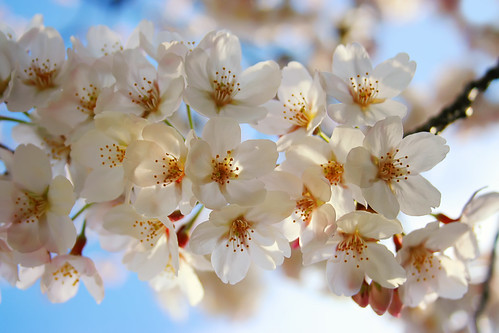I ordered the Obubu Tea sampler package several weeks ago and finally got around to a much-anticipated tasting of the Sakura Cherry Blossoms.
The sakura, or Japanese cherry blossom, symbolizes the intense ephemeral nature of life. In Japan and around the world, they welcome the spring with their vibrant pink and white blooms.
According to Obubu, their tea is from the kanzan variety of cherry blossoms. They arrived in a little plastic pouch (below).

The blossoms have been salt-pickled, and need to be stored in the fridge. Here’s what they look like below.

According to the directions, you’re supposed to soak the sakura blossoms in warm water for 5 minutes to remove the salt. Here’s what the blossom looks like after 3 minutes of soaking.

After their soak, I removed the blossom and put it into my tea cup before pouring hot water over it. After the addition of hot water, the blossom blooms exuberantly in the cup. I moved the blossom to a clear cup so you can see how beautifully the flower’s petals have unfurled.

The blossoms are gorgeous. These are the natural version of the pretty Chinese blooming flowers. This would be great to keep on your desk for a few days in a clear container.



Tasting Notes
The unsoaked salted sakura blossoms smell like a sweet candy. It reminds me a little bit of the smell of salted plum candies from the Chinese grocery store. While the liquor produced from steeping the sakura blossom is clear and virtually colorless, it has a very distinctive sakura taste, like honey, sugared plum and melon. Steeped as recommended, the flowers bloom exuberantly in the hot water and reveal a very sweet and floral taste with a complexity of flavor.
I found that two small spoonfuls of the salted steeping water did a wonderful job of offsetting the flavor of the sakura tea. The sweetness is brought out and more pronounced by the contrast of the salty water. After drinking, at the back of mouth there was a hint of tartness which was very nice.
I’m not familiar with this type of tea so I don’t plan to score it. In small portions, I could see this tea being quite enjoyable. However, personally it is too sweet to drink regularly or in anything other than small quantities. I am really looking forward to trying it in genmaicha and other teas. Apparently the salted cherry blossoms can also be used with Japanese sake, mixed with rice, cookies, and cakes. This seems like a great use for it!
You can buy these blossoms to try from yourself from Obubu Tea’s website here, or you can also take a look at their tea sampler pack to try more of their teas.
